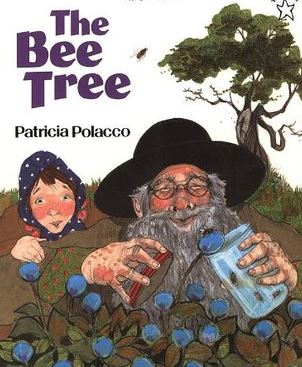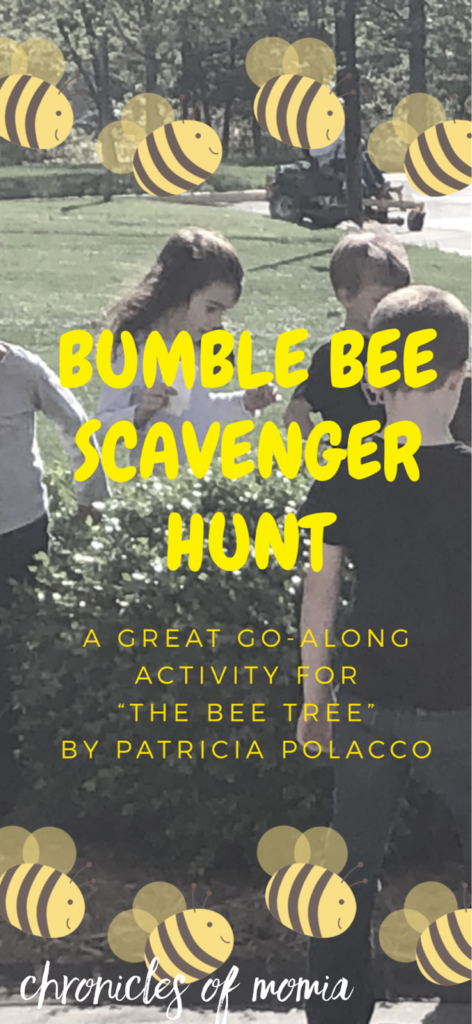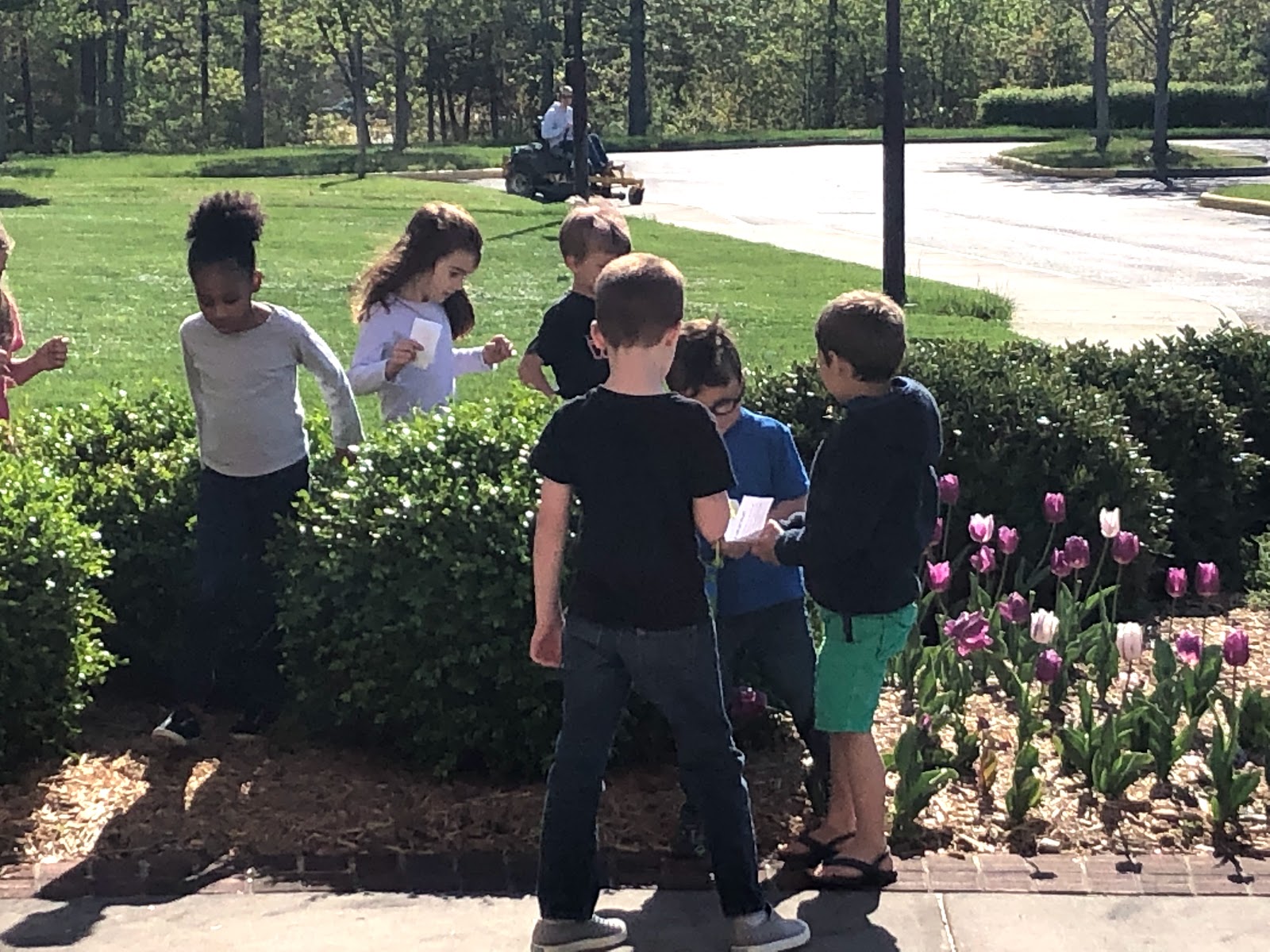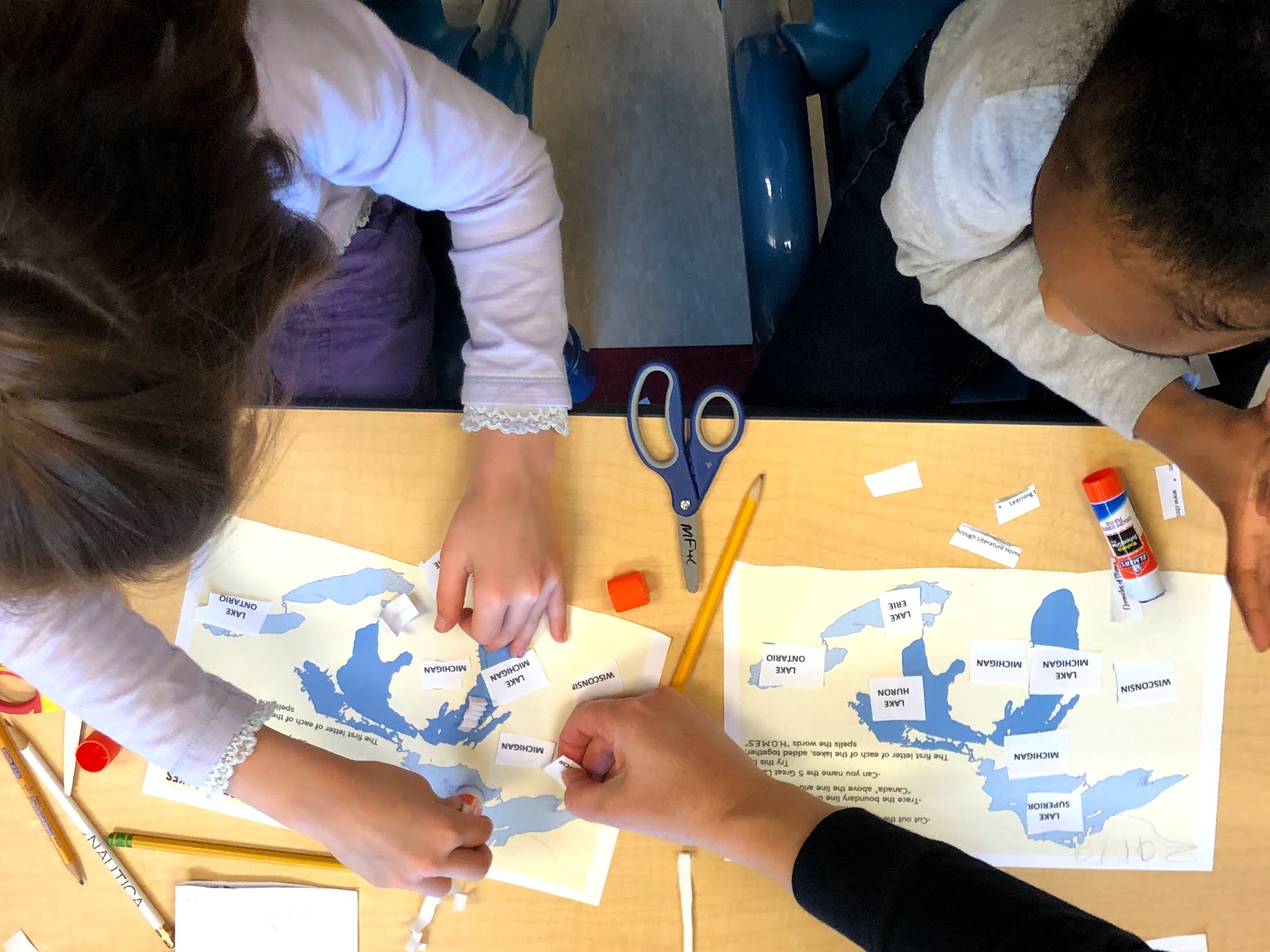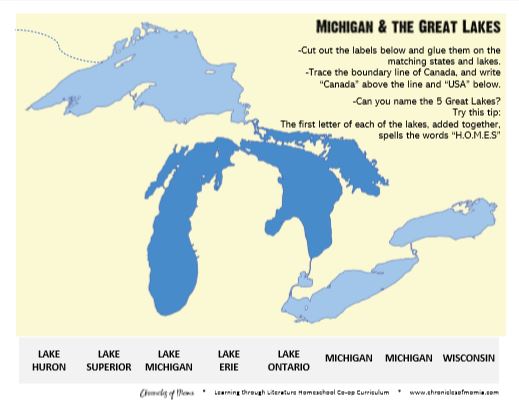If you’ve stumbled here from Pinterest, or some other site … welcome! While each of these books/lessons can stand alone, they are also a part of a year-long series that we have taught at our homeschool co-op. Each lesson builds in part on the one before. Some stories also have similar themes with the books that go before/after them. If you are interested in more information, or to see the complete booklist, check out our main page, More FIAR – Inspired Literature-Based Lesson Plans, especially for homeschool and homeschool co-ops. Thanks for looking around, and welcome to the site!
The Bee Tree
by Patricia Polacco
Things I Need:
The Bee Tree Book
The Bee Tree Handwriting Sheet
Map of the United States that shows Michigan and the Great Lakes
Michigan and the Great Lakes Map (printable below)
The Bee Tree Scavenger Hunt! (printable clues below)
Onamatopoeia Worksheet (optional, printable below)
Two other Patricia Polacco Books, Fiona’s Lace and Mrs. Katz and Tush (optional)
The Bee Tree Scavenger Hunt! (printable clues below)
Onamatopoeia Worksheet (optional, printable below)
Two other Patricia Polacco Books, Fiona’s Lace and Mrs. Katz and Tush (optional)
Scissors, Pencils, Gluesticks
Honey / Honey Sticks / Honeycomb
Bible
Honey / Honey Sticks / Honeycomb
Bible
Before Class:
Ask the students to talk to their parents (or email the parents and ask them to talk to the kiddos) about a family tradition that have. It could be something as simple as “Saturday morning pancakes” or “we dance while doing the dishes every night” .. or “we go camping every summer with grandparents”
Preview the Story:
If you haven’t read the book before, you can preview it here. There are several readings online of this story, some are read better than others. This was one my favorite of the bunch.
Review:
**Below is a suggested review, if you have time. For me, when I actually did the class, I ended up only showing the three Patricia Polacco books, discussing how she wrote all of them, then going right to the Map to show Michigan, the Great Lakes, and the “Introduce the Book” section below**
If you’ve followed this curriculum through the year …this is it! One more class to go.
At this point, it is up to you what you want to refresh the class with.
Since this book is more of a stand alone book and not connected with past lessons per say, I chose to keep it simple.
- Does anyone remember the name of the big animal in our story last week? (Lion)
- And who was the boy who showed kindness to the lion (Andy)
- And … last week we talked about these words that makes our sentences more interesting. Words like silly and slimy and hot and cold … does anyone remember what they’re called? (Adjectives)
- Annnd … our last question – there is something we started talking about during the veeeery first class of this year. If I have a word that sounds the way I spell it, like Buzz or Pop or Squeak or Choo-Choo … what are those words called? (Onomatopoeia)
Affirm or guide their answers, if needed. Then lead into today’s story.
*One optional activity, if you have been following along with the curriculum, bring along the books, Mrs. Katz and Tush by Patricia Polacco, and Fiona’s Lace by Patricia Polacco. Ask the class if they remember these two books. Then bring in today’s story, and ask them if the stories look similar. Mention that today’s story is also written and illustrated by Patricia Polacco, just like these other two. Can they seen any similarities?
Introduce the Story:
Get the class talking with these helpful intro questions:
- So what season is it now? (Spring)
- And what’s starting to happen right now outside? (Trees blooming, flowers budding, pollen)
- What about bugs? Are you starting to see bugs everywhere? What kind of bugs?
- If bees haven’t been mentioned yet, use leader questions like, “what about those bugs that buzz around the flowers? What are those called (bees)? Has anyone seen any bees yet?”
So our story today takes place in Michigan (point to Michigan on the map, mention how it has two parts that are BOTH Michigan and take a moment to mention also about how it is surrounded by the Great Lakes.)
This is the story about a grandpa who introduces his little girl to a super fun family tradition of chasing bees. *If you don’t know the science behind this – that a bee will always return to their own hive – or just how they do this (because it’s amazing!) it’s worth a 5 minutes youTube video to familiarize yourself with it, and may help talk through a few things in the story. This one was fun, short, and easy to understand – but there are many.
Introduce the Book – Class Sharing
Does chasing bees sound like a strange family tradition? What about you guys? Do you have any family traditions? Did you talk to your parents about any special things you do together as a family?
Give space for all to share (or show, if their tradition involves a physical thing), then keep going.
Read the Story:
Read through the story with the class.
There is an entire section filled with onamatopoeia words. Ask the class to raise their hand if then year one.Things to Notice as you Read:
*Both of these “reading ideas” came from the wonderful Volume 3 of the Five in a Row Curriculum. Usually I come up with my own ideas to go along with these books, but Lambert’s were perfect for this class.
There is an entire section filled with onamatopoeia words. Ask the class to raise their hand if then year one.Things to Notice as you Read:
*Both of these “reading ideas” came from the wonderful Volume 3 of the Five in a Row Curriculum. Usually I come up with my own ideas to go along with these books, but Lambert’s were perfect for this class.
The wink (on page one):
After you finish reading this first page, ask the class – why do you think he winked? We paused at the end of the first page to briefly discuss this. Can any of them wink? What does a wink mean? What do they think is going to happen?
The first picture vs. The last picture.
In the first picture, Mary Ellen is sitting down bored, with her book next to her.
In the last picture, she is sitting down on the same chair, yet now eagerly absorbed in her book
At the end of the reading, point out the two pictures and ask the class what changed?
I didn’t point this out until the end of the book, before we read what her Grandfather said on the 2nd to last page. We discussed that sometimes we don’t “feel” like doing our school work. But it takes dilligence, hard work, to learn.
We took a moment also to talk about the best book – the Bible. Sometimes we don’t feel like reading. Sometimes we’d rather do something else – but if we take the time to seek and search out what’s inside we will discover wonderful treasures. (This is just as true for adults)
Class Activity – Follow the Bee Scavenger Hunt:
As soon as we finished the book, and the discussion above, I had the class line up by the door. They were all excited. I told them we were going to go on our own search for honey. We couldn’t use bees, because that might be a little dangerous … but we were going to use clues instead. I read Clue #1 to the class, and they were off. Just like Bees, they went off on their adventure, collected clues/pollen, and came back to their hive home to make/get honey. It was a great pictures – and the kids LOVED it.
There are plenty of other things we could have done. We could have spent more time on Onamatopoeia… but we’ve done that quite a bit this year. We could have done more with the geography of Michigan. Of course there is tons to do with science and art for bees (but at our co-op, that’s covered in two others classes). So I really struggled with what to do. Until at 1:30 in the morning I prayed … and then it came :). Yes, that is how I prepare for co-op much of the time.
What followed was this super fun bee scavenger hunt. I just happened to have some honey sticks at my house, enough for all the kids. If you do – awesome. If not, a jar of honey and crackers would work, a honeycomb would be even better, or even honey, tea, and biscuits, like it talks about in the book – would all be perfect to leave in the final spot as the thing they are “searching” for.
When I created these clues, I left them generic enough to work with most any building.
Before Class:
Hide Clue #1 read in class, before they leave
Hide Clue #2 in a bathroom
Hide Clue #3 outside in a flower bed or on the grass
Hide Clue #4 in the kitchen
The Final Rhyme: back in the classroom (or location) that they started in. You can either have it in a hidden spot before they leave, or have a helper put the treat out on the table for when the come back. I placed my honey sticks on top of a Bible.
The Final Rhyme: back in the classroom (or location) that they started in. You can either have it in a hidden spot before they leave, or have a helper put the treat out on the table for when the come back. I placed my honey sticks on top of a Bible.
Kids loves scavenger hunts – but this one is double the fun because this is exactly what bees do. And this is exactly what was done in the book. Grandfather and Mary Ellen seek the treasure. They chase the bees all over the place until the bees end up where – right back where they started at the beginning of their day. Bees always return home, with fresh pollen to make honey. And of course, the kiddos are going out from their classroom “home”, then chasing “clues”, like Mary Ellen chased the bees, and then returning “home”, where they find the honey. There are lots of little lessons. But this is fun and memorable, and a great way to get the lesson a little deeper in a fun interactive way.
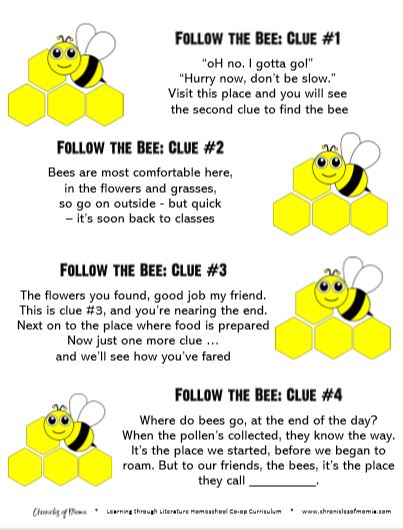 |
| Click here for printable version |
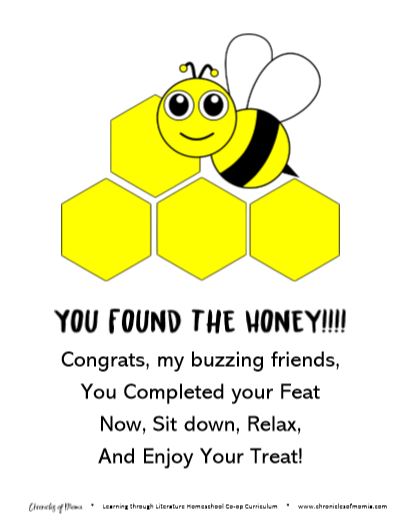 |
| Click here for printable version |
If the class makes it back in time to enjoy their treat, this would be a great time to remind them of the The Bee Tree, and of Grandfather’s exhortation to “pursue” – adventure, knowledge, and wisdom.”
- Was it easy for them to get the honey?
- Would it have been easier for me to just give them the honey sticks?
But just like Grandfather and Mary Ellen pursued the bees diligently to find the honey, and just like we pursued the honey sticks, by diligently completing the scavenger hunt, so also there is a treasure in books, and especially the Bible, that needs to be pursued as we grow older.
Class Activity – Great Lakes Geography:
When we came back to class, the kids settled down with their honey sticks. We found Michigan on the map again and discussed that it is surrounded by the 5 Great Lakes. We talked about the size of these (looks like an Ocean), that you coudn’t see across them, and the acronym to remember them *H.O.M.E.S.
We talked about how Michigan looks like an oven mitt, and is uniques because it has two parts
We talked about how Lake Superior is easy to remember because its at the top, it thinks its “superior”
Lake Michigan is easy to remember because it’s right next to Michigan
We cut out our squares, glued the squares in the right spot, and labeled the USA and Canada.
This was a simple exercixe, mainly for exposure… and a good way to calm down after our adventurous Honey Scavenger Hunt.
|
|
Click here for printable version |
Handwriting Sheet:
Remind the class to start their letters at the top.
If you’d like to refer back to the Bee Scavenger Hunt and the lessons learned in “seeking something”, it may proove helpful.
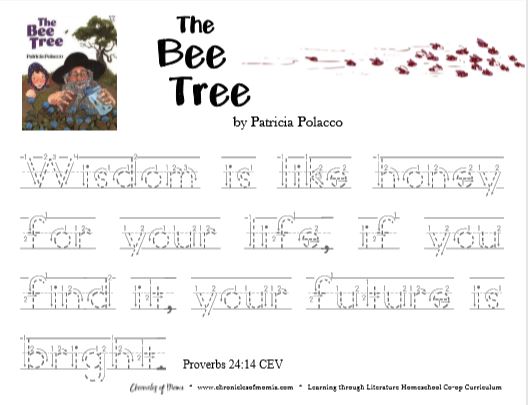 |
| Click here for printable version |
That’s it for this week! To see what we’ve done so far in our Homeschool Co-op’s Literature Series this year, click here. Each lesson builds on the one before and seeks to cover basic geography within the book, historical contexts, a handwriting sheet and a language arts lesson, as it applies to the book.
Or, you can check out the complete Learning the ABC’s through Literature Series, which is a similar series that we did with this same group of kiddos a year earlier. Both of these series of books have been inspired by the Five in a Row curriculum, with many of the books being the same. The ideas, implementation of it for a co-op, and printables are all my own, unless otherwise indicated.
Also – I would love to hear from you! If you have feed back, suggestions, or questions … or if you have used this in some way … please, share a picture, post a note, or just say hi. Especially if you’re using this for a co-op … it’s great to get ideas and share them around to help each other!
Thanks for reading!

